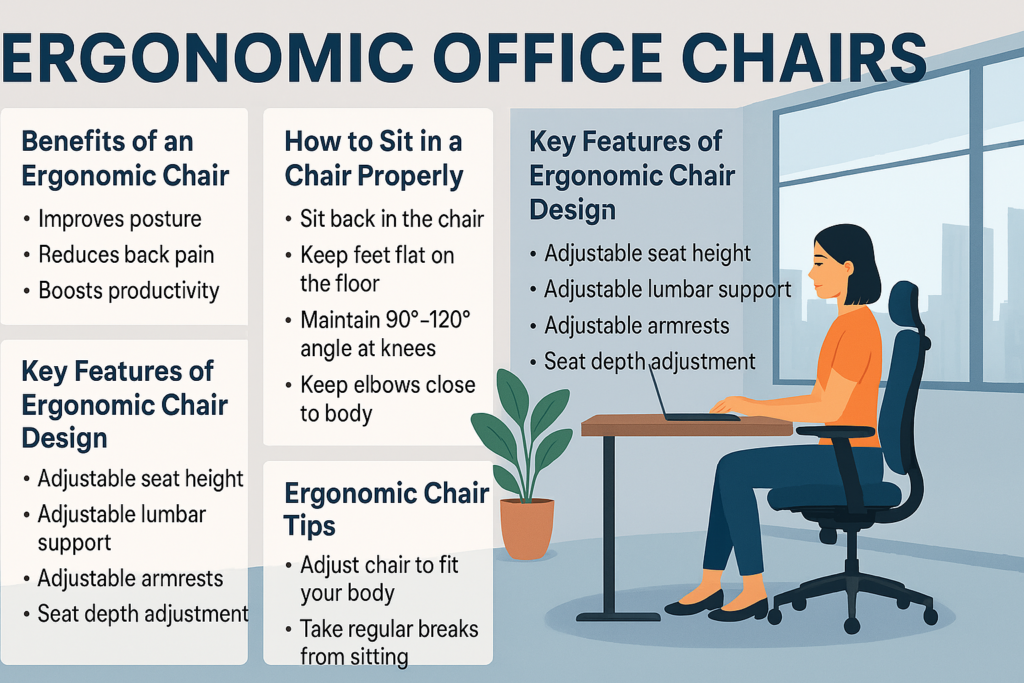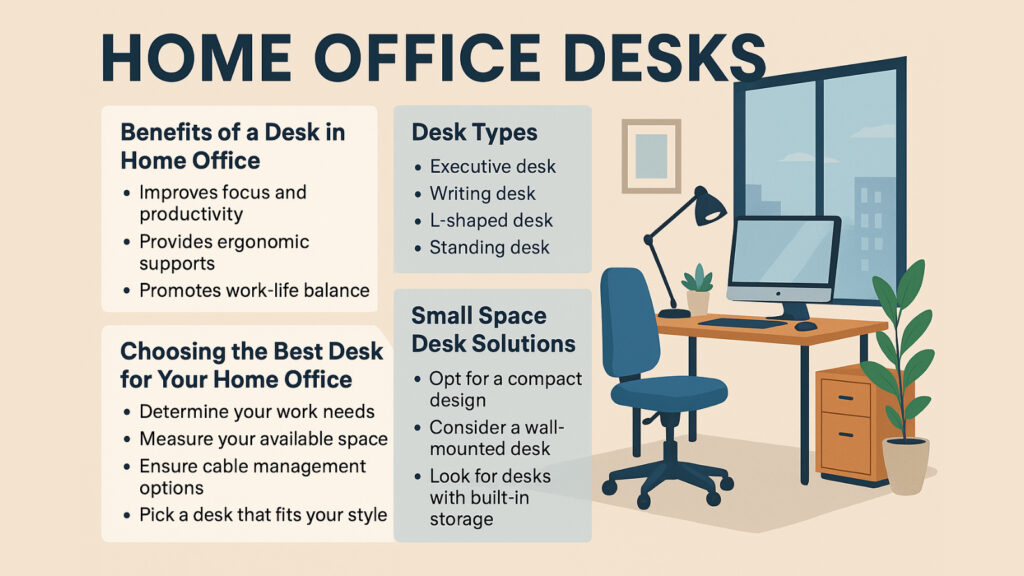Working long hours at a desk shouldn’t leave you feeling drained and achy. Yet for many office workers, remote employees, business owners, and even office designers, this is the reality. The solution? A well-designed ergonomic office chair.
Investing in the right chair doesn’t just enhance your comfort; it can also boost productivity, minimize discomfort, and protect your long-term health. This guide will walk you through everything you need to know about ergonomic chairs, including how to choose one that suits your needs and the best practices for sitting correctly.

What Makes an Office Chair Ergonomic?
An ergonomic chair is more than just a seat with added padding. It’s specifically designed to support your body in ways that promote good posture and reduce strain on your muscles and joints. Here are the essential features that make a chair ergonomic and why each one matters.
1. Adjustable Seat Height
An adjustable seat height allows the chair to align properly with your desk setup and your body dimensions. When correctly adjusted:
- Your feet should rest flat on the floor.
- Your knees should bend at a 90-degree angle.
This promotes blood circulation and prevents leg fatigue.
2. Lumbar Support
The lower back naturally curves inward. A proper ergonomic chair provides lumbar support that fills this curve, keeping your spine in a healthy, neutral position. Without it, prolonged slouching can lead to chronic back pain.
3. Seat Depth and Width
A chair’s seat should be deep enough to support your thighs but leave about 2-3 inches of space behind your knees. This ensures even weight distribution and minimizes pressure on sensitive areas.
4. Armrests
Good armrests keep your shoulders relaxed and elbows supported. Ergonomic chairs typically allow you to adjust armrest height and angle to prevent strain on your neck and shoulders.
5. Swivel and Mobility
An ergonomic chair isn’t complete without smooth swivel and mobility. These features make it easier to reach items around your desk without twisting uncomfortably or overextending. Plus, wheels save time and energy when you need to move around your workspace.
How to Sit in a Chair Properly
Even the most advanced ergonomic chair can’t work its magic if you don’t use it correctly. Mastering proper sitting posture takes time but can drastically improve your day-to-day comfort.
Key Guidelines for Proper Sitting
- Sit All the Way Back: Make sure your lower back is fully supported by the chair’s lumbar cushion.
- Keep Feet Flat: Rest your feet completely on the floor or use a footrest if needed. Dangling feet can cause hip discomfort over time.
- Adjust Seat Height: Set the seat high enough so your thighs are parallel to the floor but not so high that you’re hunching over.
- Align Your Screen: Position your computer monitor at eye level to avoid neck strain.
- Maintain Arm Angles: Keep your arms at a 90-degree angle while using a keyboard or mouse to minimize wrist tension.
Remember, ergonomic sitting also requires regular breaks. Standing, stretching, and moving around every 30 minutes can prevent stiffness and improve circulation.
Choosing the Right Ergonomic Chair Design
There’s no one-size-fits-all when it comes to ergonomic chairs. Depending on your work environment and personal preferences, you may find one design suits you better than others. Here’s a breakdown of popular ergonomic chair styles to consider.
1. Mesh Chairs
Mesh chairs provide excellent breathability, which is ideal for warm climates or long working hours. They offer firm support and prevent you from overheating, making them a favorite in modern office spaces.
2. Executive Chairs
These chairs are large, cushioned, and often crafted with premium materials like leather. Perfect for higher-up executives or anyone who values aesthetics alongside comfort, executive chairs combine luxury with functionality.
3. Task Chairs
Task chairs are lightweight and easy to move, great for dynamic workplaces where frequent repositioning is common. They often lack the bulk of executive chairs, making them affordable and space-efficient.
4. Kneeling Chairs
A unique option to promote active sitting, kneeling chairs shift weight to your shins while keeping your spine in alignment. While they may not be ideal for prolonged use, they’re excellent for improving posture in short bursts.
When choosing a chair, always test it out if possible. Sit in it for at least 15 minutes to evaluate both its comfort level and how well it encourages proper posture.
Maintaining Your Ergonomic Chair
Your ergonomic chair is a long-term investment, but it requires care to keep it functioning optimally. Proper maintenance not only extends your chair’s lifespan but also ensures you continue to get the maximum benefits.
Maintenance Tips
- Readjust Regularly: Check your chair adjustments every few weeks to accommodate subtle changes in your posture or desk setup.
- Keep It Clean: Dust off and wipe down surfaces, especially if your chair has fabric or mesh seating that can trap dirt.
- Inspect Moving Parts: Check the wheels, swivel mechanism, and gas lift for any signs of wear and tear. Apply lubricant to parts as needed to maintain smooth movement.
If your chair feels less effective as the years go on, it may be worth replacing or upgrading to a newer model with improved features.
Small Change, Big Impact
Transforming your workspace doesn’t have to involve a complete overhaul. Investing in a well-designed ergonomic office chair is a small change that delivers a big boost to your comfort, productivity, and overall health.
From adjustable seat height to lumbar support and beyond, the right chair sets the foundation for a better workday. Pair it with proper sitting habits and regular maintenance, and you’ll create an environment where you can truly thrive.
If you’re ready to upgrade your workspace, explore our curated selection of ergonomic chairs crafted to suit every need and style. Here’s to a healthier, more productive work experience!

